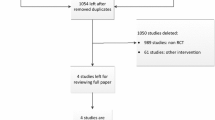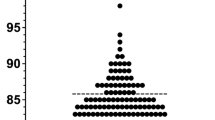Abstract
Objective
To evaluate the clinical efficacy of total knee arthroplasty (TKA) in the treatment of primary osteoarthritis (OA) and osteoarthritis of Kashin-Beck disease (KBD).
Methods
This study enrolled 77 KBD patients (77 knees, KBD-TKA) and 75 OA patients (75 knees, OA-TKA) who underwent TKA from September 2008 to June 2018. Clinical assessments for each patient were performed pre-operatively and last follow-up. The efficacy measures included the visual analogue scale (VAS) pain score, range of motion (ROM), Hospital for Special Surgery (HSS) score, and short form 36 Health Survey (SF-36) as well as related influencing factors between the two groups.
Results
All patients were followed up; the follow-up time of KBD-TKA was 14–132 months, with an average of 72.68 ± 37.55 months; OA-TKA was 15–120 months, with an average of 49.2 ± 28.91 months. There was no difference in pre-operative VAS score (7.29 vs. 7.24) and SF-36 (PCS) score (4.87 vs. 5.49) between KBD-TKA and OA-TKA (P > 0.05), while compared with OA, KBD-TKA had significantly worse pre-operative ROM (75.48° vs. 82.87°), HSS score (36.40 vs. 41.84), and SF-36 (MCS) score (26.28 vs. 28.73) (P < 0.05). At the final follow-up, there was no significant difference in VAS score (1.13 vs. 1.16), ROM (105.79 vs. 105.79), and HSS score (92.06 vs. 92.25) between KBD-TKA and OA-TKA (P > 0.05), while compared with OA, KBD-TKA had significantly worse SF-36 (PCS) score (36.90 vs. 42.00) and SF-36 (MCS) score (55.16 vs. 59.70) (P < 0.05). In a multivariate regression, controlling for multiple potential confounders, diagnosis of KBD was associated with poor quality of life after surgery, whereas pre-operative pain was specifically associated with post-operative pain. However, preoperative gender, age, BMI, and the angles of knee prosthesis (before and after surgery) were not associated with post-operative outcome.
Conclusion
Patients with KBD undergoing primary TKA have excellent outcomes, comparable with OA at the final follow-up, in spite of worse pre-operative ROM, HSS score, and SF-36(MCS) score. However, KBD patients are worse than OA in terms of general health. Pre-operative age, gender, BMI, and the angles of knee prosthesis were not the factors influencing the clinical efficacy of TKA. The diagnosis of KBD was an independent risk factor for poor quality of life after TKA. Pre-operative pain was a clinically important predictor of outcome.

Similar content being viewed by others
References
Li Y et al (2013) Clinical features of Kashin-Beck disease in adults younger than 50 years of age during a low incidence period: severe elbow and knee lesions. Clin Rheumatol 32(3):317–324
Schepman K et al (2011) Kashin Beck disease: more than just osteoarthrosis: a cross-sectional study regarding the influence of body function-structures and activities on level of participation. Int Orthop 35(5):767–776
Guo X et al (2014) Recent advances in the research of an endemic osteochondropathy in China: Kashin-Beck disease. Osteoarthr Cartil 22(11):1774–1783
Leigang, Y., et al., Stabilized prosthesis after total knee arthroplasty for the adult Kaschin-Beck disease with mixed deformities. 2012
Judge A et al (2012) Predictors of outcomes of total knee replacement surgery. Rheumatology (Oxford) 51(10):1804–1813
Tang X et al (2014) Total knee arthroplasty in elderly patients with severe Kashin-Beck disease of the knee. Int Orthop 38(4):753–759
Jin ZK et al (2019) Outcomes of total knee arthroplasty in the adult Kashin-Beck disease with severe osteoarthritis. Int Orthop 43(2):323–331
Singh JA et al (2010) Predictors of moderate-severe functional limitation after primary total knee arthroplasty (TKA): 4701 TKAs at 2-years and 2935 TKAs at 5-years. Osteoarthr Cartil 18(4):515–521
Xiong G (2001) Diagnostic, clinical and radiological characteristics of Kashin-Beck disease in Shaanxi Province. PR China Int Orthop 25(3):147–150
Fu Q et al (2015) Radiographic features of hand osteoarthritis in adult Kashin-Beck disease (KBD): the Yongshou KBD study. Osteoarthr Cartil 23(6):868–873
Lam CL et al (2005) The SF-36 summary scales were valid, reliable, and equivalent in a Chinese population. J Clin Epidemiol 58(8):815–822
Ling M et al (2017) Staged total knee arthroplasty for bilateral complex knee deformities from Kashin-Beck disease and skeletal dysplasia. Knee 24(3):692–698
Clement ND et al (2011) The outcome of primary total hip and knee arthroplasty in patients aged 80 years or more. J Bone Joint Surg (Br) 93(9):1265–1270
Cushnaghan J et al (2007) Long-term outcome following total hip arthroplasty: a controlled longitudinal study. Arthritis Rheum 57(8):1375–1380
Ethgen O et al (2004) Health-related quality of life in total hip and total knee arthroplasty. A qualitative and systematic review of the literature. J Bone Joint Surg Am 86(5):963–974
MacWilliam CH et al (1996) Patient-related risk factors that predict poor outcome after total hip replacement. Health Serv Res 31(5):623–638
Johansson HR et al (2010) Impact of preoperative function on early postoperative outcome after total hip arthroplasty. J Orthop Surg (Hong Kong) 18(1):6–10
Lingard EA et al (2004) Predicting the outcome of total knee arthroplasty. J Bone Joint Surg Am 86(10):2179–2186
Cushnaghan J et al (2009) Long-term outcome following total knee arthroplasty: a controlled longitudinal study. Ann Rheum Dis 68(5):642–647
Hofstede SN et al (2018) The influence of preoperative determinants on quality of life, functioning and pain after total knee and hip replacement: a pooled analysis of Dutch cohorts. BMC Musculoskelet Disord 19(1):68
Singh JA, Gabriel S, Lewallen D (2008) The impact of gender, age, and preoperative pain severity on pain after TKA. Clin Orthop Relat Res 466(11):2717–2723
Santaguida PL et al (2008) Patient characteristics affecting the prognosis of total hip and knee joint arthroplasty: a systematic review. Can J Surg 51(6):428–436
Kane RL et al (2005) The functional outcomes of total knee arthroplasty. J Bone Joint Surg Am 87(8):1719–1724
Slevin O, Amsler F, Hirschmann MT (2017) No correlation between coronal alignment of total knee arthroplasty and clinical outcomes: a prospective clinical study using 3D-CT. Knee Surg Sports Traumatol Arthrosc 25(12):3892–3900
Huijbregts HJ et al (2016) Prosthetic alignment after total knee replacement is not associated with dissatisfaction or change in Oxford knee score: a multivariable regression analysis. Knee 23(3):535–539
Mugnai R et al (2016) Clinical outcome is not affected by total knee arthroplasty alignment. Knee Surg Sports Traumatol Arthrosc 24(10):3339–3345
Longstaff LM et al (2009) Good alignment after total knee arthroplasty leads to faster rehabilitation and better function. J Arthroplast 24(4):570–578
Choong PF, Dowsey MM, Stoney JD (2009) Does accurate anatomical alignment result in better function and quality of life? Comparing conventional and computer-assisted total knee arthroplasty. J Arthroplast 24(4):560–569
Funding
The preidential foundation of The Fourth Affiliated Hospital of Harbin Medical University (HYDSYYZ201504).
Author information
Authors and Affiliations
Corresponding author
Ethics declarations
This study was approved by the Human and Ethics Committee for Medical Research at The Fourth Affiliated Hospital of Harbin Medical University. Informed consent was obtained for all patients prior to their inclusion in the study.
Conflict of interest
The authors state that they have no conflict of interest.
Additional information
Publisher’s note
Springer Nature remains neutral with regard to jurisdictional claims in published maps and institutional affiliations.
Hui-Min Liu and Ya-Fei Wang are the co-first authors.
Rights and permissions
About this article
Cite this article
Liu, HM., Wang, YF., Wu, JM. et al. A comparative study of clinical effect of total knee arthroplasty in the treatment of primary osteoarthritis and osteoarthritis of Kashin-Beck disease. International Orthopaedics (SICOT) 44, 1719–1726 (2020). https://doi.org/10.1007/s00264-020-04542-9
Received:
Accepted:
Published:
Issue Date:
DOI: https://doi.org/10.1007/s00264-020-04542-9




